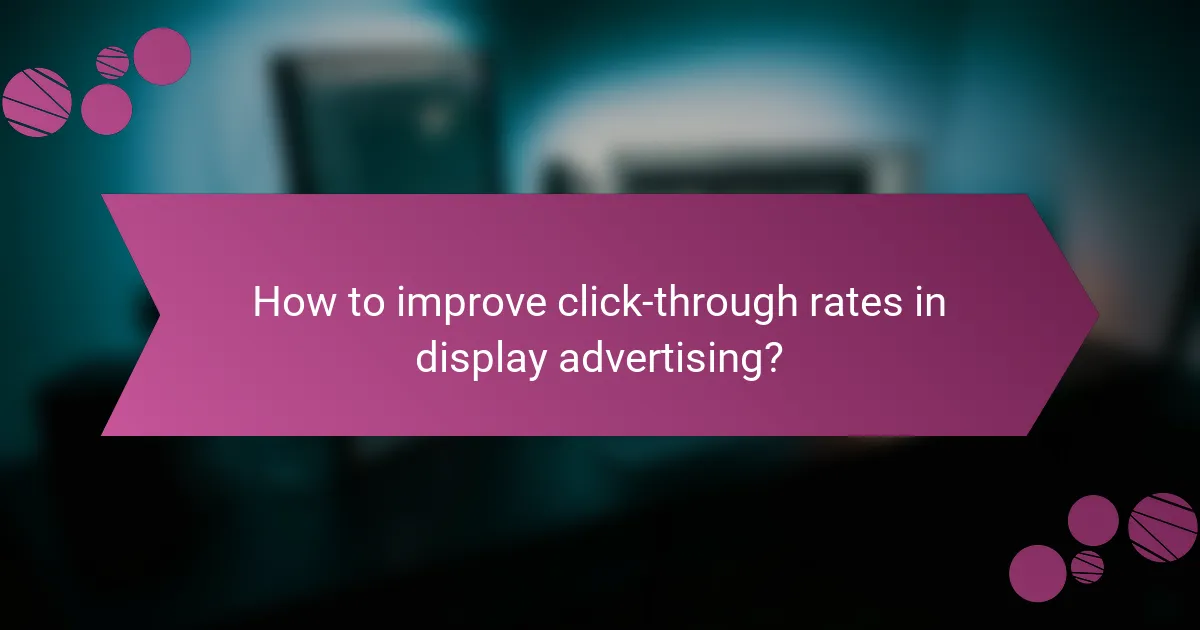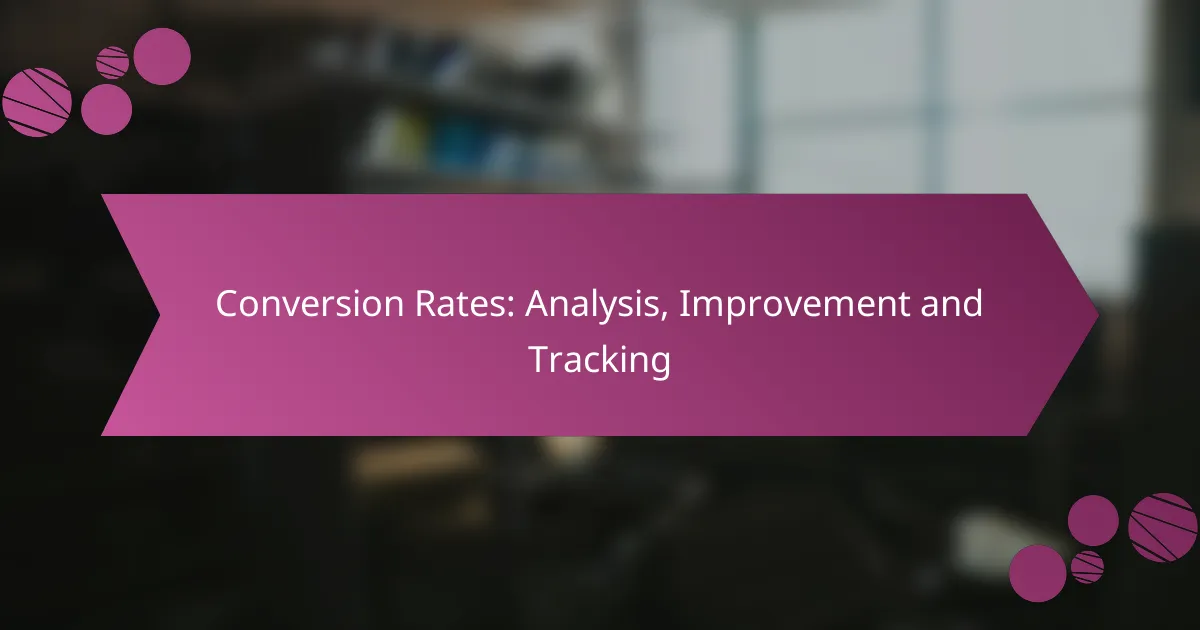Click-through rate (CTR) is a crucial metric that measures the effectiveness of online advertising by indicating the percentage of users who click on an ad compared to those who view it. A higher CTR signifies a successful ad that resonates with its audience, driving engagement and traffic. To optimize CTR, advertisers must focus on enhancing ad relevance, quality, and strategic placement, ultimately improving overall campaign performance.

How to improve click-through rates in display advertising?
Improving click-through rates (CTR) in display advertising involves enhancing the visual appeal, strategic placement, and targeting of your ads. By focusing on these aspects, advertisers can significantly increase engagement and drive more traffic to their websites.
Utilize eye-catching ad designs
Eye-catching ad designs are crucial for capturing attention in a crowded digital space. Use vibrant colors, bold fonts, and compelling images to create ads that stand out. Ensure that your branding is clear and that the message is concise, ideally fitting within a few words that convey the main benefit.
Consider incorporating animations or interactive elements, as these can further engage viewers. However, keep in mind that overly complex designs may detract from the core message, so balance is key.
Optimize ad placement on websites
Ad placement significantly impacts CTR. Position your ads where users are most likely to see them, such as above the fold or within content that aligns with the ad’s message. Research shows that ads placed in prominent areas can achieve higher visibility and engagement.
Additionally, consider the context of the website. Ads on relevant sites or pages can resonate better with the audience, increasing the likelihood of clicks. Avoid placing ads in areas where users may not expect to see them, as this can lead to lower engagement.
Test different ad formats
Experimenting with various ad formats can help identify which ones resonate best with your audience. Options include static banners, video ads, and rich media formats. Each format has its strengths; for instance, video ads often yield higher engagement rates but may require more resources to produce.
Monitor performance metrics for each format to determine which generates the highest CTR. This data-driven approach allows for informed decisions on future ad campaigns.
Implement A/B testing strategies
A/B testing is a powerful method for optimizing CTR. By creating two versions of an ad and testing them against each other, you can identify which elements drive better performance. Focus on variables such as headlines, images, and call-to-action buttons.
Run tests over a sufficient period to gather meaningful data, and ensure that the sample size is large enough to draw reliable conclusions. Use the insights gained to refine your ads continuously.
Leverage audience targeting techniques
Effective audience targeting can significantly enhance CTR by ensuring that your ads reach the right people. Utilize demographic data, interests, and online behavior to tailor your ads to specific segments. This personalized approach increases relevance and engagement.
Consider using retargeting strategies to reach users who have previously interacted with your brand. This can remind potential customers of their interest and encourage them to click through to your site.

What factors influence click-through rates?
Click-through rates (CTR) are influenced by several key factors, including the relevance of ads to user intent, the quality of ad copy and visuals, and the loading speed of the website. Understanding these elements can help optimize CTR and improve overall campaign performance.
Ad relevance to user intent
Ad relevance to user intent is crucial for achieving higher click-through rates. Ads that align closely with what users are searching for tend to attract more clicks. For example, if a user searches for “best running shoes,” an ad promoting a specific brand of running shoes will likely perform better than a generic footwear ad.
To enhance relevance, conduct thorough keyword research and tailor your ads to match the specific needs and interests of your target audience. This may involve using dynamic keyword insertion or creating multiple ad variations for different segments.
Quality of ad copy and visuals
The quality of ad copy and visuals significantly impacts click-through rates. Engaging headlines, clear calls to action, and appealing images or videos can capture attention and encourage users to click. For instance, an ad that highlights a limited-time offer with vibrant visuals is more likely to attract clicks than a bland, text-heavy ad.
To improve ad quality, focus on crafting compelling messages that resonate with your audience. A/B testing different versions of your ads can help identify which elements drive higher engagement and CTR.
Website loading speed
Website loading speed plays a vital role in click-through rates, as slow-loading pages can lead to higher bounce rates. Users expect pages to load quickly, ideally within a couple of seconds. If a website takes too long to load, potential customers may abandon the site before it fully appears.
To optimize loading speed, compress images, minimize code, and utilize content delivery networks (CDNs). Regularly testing your website’s performance can help identify bottlenecks and ensure a smooth user experience, ultimately supporting higher CTRs.

What is the definition of click-through rate?
Click-through rate (CTR) is a metric that measures the percentage of users who click on a specific ad or link compared to the total number of users who view it. A higher CTR indicates that the ad is effective in attracting attention and prompting action.
Percentage of users who click on an ad
The percentage of users who click on an ad is calculated by dividing the number of clicks by the number of impressions, then multiplying by 100. For instance, if an ad receives 100 clicks from 10,000 impressions, the CTR would be 1%. Generally, a CTR of 2-5% is considered average, while anything above 5% is often viewed as excellent.
Understanding the percentage of users who click on an ad helps advertisers assess the effectiveness of their campaigns. A low CTR may indicate that the ad is not resonating with the target audience or that the placement is suboptimal.
Calculation method for click-through rate
To calculate the click-through rate, use the formula: CTR = (Clicks / Impressions) x 100. This straightforward calculation provides a clear picture of how well an ad is performing. It’s essential to track this metric over time to identify trends and make necessary adjustments.
When optimizing for CTR, consider factors such as ad copy, visuals, and targeting. A/B testing different versions of ads can help determine which elements lead to higher engagement. Avoid common pitfalls like using misleading headlines, which can lead to high impressions but low clicks, ultimately harming your campaign’s credibility.

How does click-through rate impact advertising performance?
Click-through rate (CTR) significantly influences advertising performance by measuring the effectiveness of ads in attracting user engagement. A higher CTR typically indicates that an ad resonates well with its audience, leading to better conversion rates and lower costs per acquisition.
Influences ad placement costs
CTR directly affects the costs associated with ad placements, particularly in pay-per-click (PPC) advertising models. Advertisers with higher CTRs often benefit from lower costs per click, as platforms like Google Ads reward effective ads with better positioning and lower bid requirements.
For example, if an ad campaign achieves a CTR of 5% compared to a competitor’s 1%, the advertiser may pay significantly less per click while gaining more visibility. This dynamic can lead to substantial savings over time, making it crucial to optimize CTR.
Affects overall campaign effectiveness
The overall effectiveness of an advertising campaign is heavily influenced by its CTR. A high CTR not only indicates strong audience interest but also correlates with improved quality scores on advertising platforms, which can enhance ad visibility and reduce costs.
To maximize campaign effectiveness, focus on creating compelling ad copy and targeting the right audience. Regularly analyze performance metrics and adjust strategies based on what drives higher engagement. Avoid common pitfalls, such as ignoring A/B testing, which can help identify the most effective ad variations.

What tools can help optimize click-through rates?
Several tools can effectively optimize click-through rates (CTR) by providing insights into performance, competition, and audience behavior. Utilizing these tools can help identify areas for improvement and enhance overall campaign effectiveness.
Google Ads for performance tracking
Google Ads is a powerful platform for tracking the performance of your ads and understanding user engagement. It provides detailed metrics such as CTR, conversion rates, and cost-per-click (CPC), allowing you to analyze which ads resonate with your audience.
To optimize your CTR using Google Ads, regularly review your ad performance and conduct A/B testing on different ad copies and formats. Focus on improving headlines and descriptions, as these elements significantly influence user clicks. Aim for a CTR above 2% for most industries, but adjust expectations based on your specific niche.
SEMrush for competitive analysis
SEMrush is an excellent tool for conducting competitive analysis, helping you understand how your competitors are performing in terms of CTR. By analyzing their keywords, ad copies, and landing pages, you can identify successful strategies and areas where you can differentiate your ads.
Utilize SEMrush to track competitor ad placements and performance metrics. This can guide your keyword selection and ad copy improvements. Regularly benchmarking against competitors can help you stay competitive and aim for a CTR that exceeds industry averages, which typically range from 1% to 5% depending on the sector.

What are common mistakes that lower click-through rates?
Common mistakes that lower click-through rates (CTR) include poor targeting, unappealing ad copy, and lack of clear calls to action. These errors can lead to missed opportunities for engagement and conversions.
Poor Targeting
Poor targeting occurs when ads are shown to audiences that are not interested in the product or service. This can happen due to incorrect demographic settings or misaligned keywords. To improve targeting, utilize audience insights and analytics to refine who sees your ads.
Unappealing Ad Copy
Unappealing ad copy can significantly reduce CTR. If the language is bland or fails to resonate with the audience, potential clicks will be lost. Focus on crafting compelling headlines and engaging descriptions that highlight benefits and evoke curiosity.
Lack of Clear Calls to Action
A lack of clear calls to action (CTAs) can confuse users about what to do next. Effective CTAs should be direct and action-oriented, such as “Shop Now” or “Learn More.” Ensure that your CTAs stand out visually and are placed prominently within the ad.









